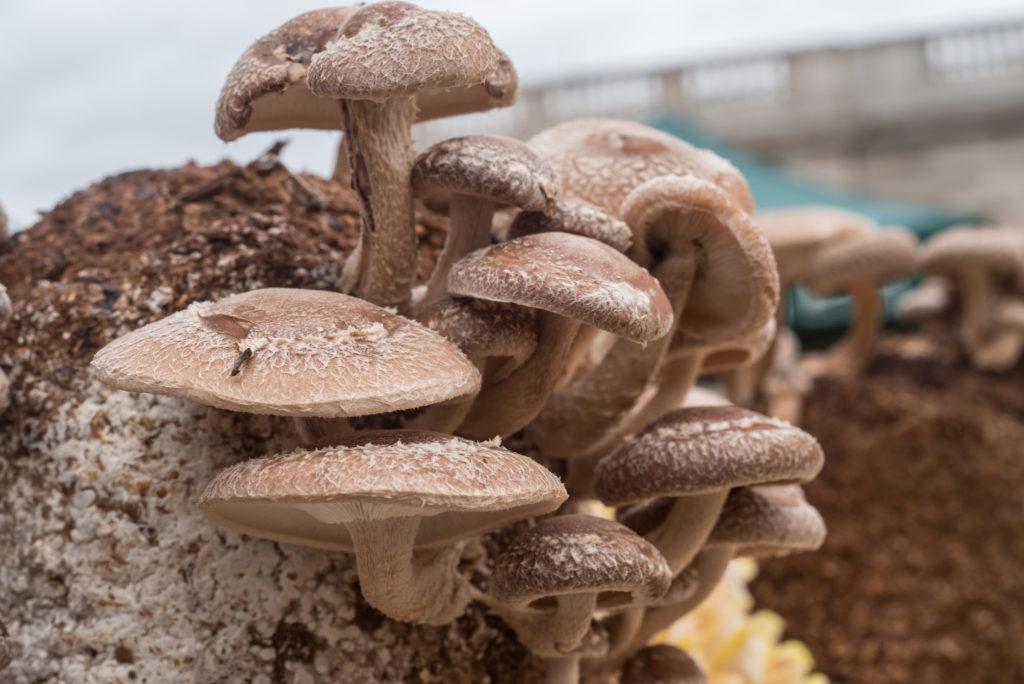- Find a reputable source for spawn! As with any crop, a successful mushroom harvest is never a given, but you can increase your success by buying your spawn from a reliable company. You can think about spawn like seeds for plants. Still, unlike seeds, mycelium ( a network of fungal threads) needs a carrier to hold the specific mushroom mycelium in "stasis" until it is transferred or inoculated onto a substrate. Spawn can come in multiple forms, from sawdust, wood plugs, and grain. A substrate can be wood logs, straw, compost, cardboard, soil, and even toilet paper tubes, depending on the specific needs of the mycelium and your growing environment. Cornell Cooperative Extension has a directory of suppliers.
- Sourcing logs! Moving logs across state lines should not occur and can spread pests and plant diseases. Find a local arborist in Maryland or connect with the parks department as potential suppliers if you plan to grow mushrooms on logs.
- Keep your operation contaminant-free! Make sure there are no competing organisms on your substrate. In indoor production and controlled environment cultivation, you can use sterilization or pasteurization techniques before colonizing your substrate. Outdoor cultivation can be more challenging to ensure a clean environment. A rule of thumb for log cultivation is to use clean, fresh hardwood and never use dead or dying logs. Mushrooms grown on logs have a preference, so do your research to find out what type of wood your mushroom prefers for outdoor production methods.
- Interested in using manure as your substrate? Learn more about Maryland's Manure Transport program
- Find out what is in your soil! Some mushrooms, like Wine Caps, grow easily in garden beds. They grow under plants like tomatoes and cucumbers that ensure shade and moisture. Unlike most vegetables, mushrooms are wonderful little sponges and will soak up and metabolize contaminants from the soil. So, get your soil tested for heavy metals and lead before incorporating mushrooms. If you are growing mushrooms in raised beds in an urban setting or if there is a risk of soil contamination, use a non-porous material like plastic as a barrier between the area's soil and the bed's imported soil or compost and plant on a slope to ensure good water drainage when using a barrier.
- Be preventative! To decrease contamination when working on your mushroom operation, always start by wearing clean clothes. If you are growing inside, try to separate your rooms. For example, keep your mushroom production separate from your composting area. Set up your workflow to move from the cleanest area (most likely your inoculation room) to the dirtiest area, like where you keep your compost or farm/garden tools. Remember, There will always be pathogens, and there will always be a host. Hence, the best thing you can do is manage the environment and modify growth conditions as needed.
- Understand your state's food safety standards! UME is always here to help growers obtain the training and certifications they need to meet state standards. The American Mushroom Institute (AMI) is a National Trade Association and an excellent resource for producers of cultivated mushrooms.
- Take the time to develop your Business Plan! An initial business plan will lay the foundation for customer discovery and market research.
- Understand the difference between customer discovery and market research! Customer discovery is the process of continuously testing the hypothesis that underlies your business model by listening to your customer's needs and preferences. Market research is the process of gathering and interpreting data about your target market, customer, and competitors. Both processes are done in tandem. Being open to necessary shifts revealed will make your farm or food venture more resilient.
- Do your marketing research! Find out who your customers are, what they want, what they are willing to pay for, and at what price. It is also a good idea to find out what varieties are grown and sold in your area.
- Know your market competitors! There are so many delicious specialty mushrooms. Consider filling a niche that hasn't already been filled. Be careful about making nutritional and medicinal claims on your packaging or advertising, because those claims are regulated by the US Food and Drug Administration.
- Talk with your farmers' market! If you plan to sell at farmers' markets, find out if there are already mushroom sellers and what varieties they are selling. Many markets will only allow one mushroom vendor. However, if you provide a different specialty variety, there may be room for an additional vendor.
More information is available from Cornell University at https://smallfarms.cornell.edu/projects/mushrooms/, and they provide excellent outdoor production guides at https://blogs.cornell.edu/mushrooms/factsheets/. More information about specialty mushroom production, green mold, pests, and more can be found through Penn State Extension at https://extension.psu.edu/catalogsearch/result/?q=mushrooms.
For more information on starting a new farm venture, go to the UME Beginning Farmer Success program page.
